Steps for Creating Your Online Marketing Strategy
- Create "What do we want to..." Lists
- Brainstorm Business Goals
- Add Time Frames
- Choose The Most Important Goals
- Determine The Purpose
- Develop A MAP
- Setting 90 Day SMART Goals
- Keep a Compelling Scoreboard
- Hold Your Team Accountable
People that succeed in developing an effective digital marketing strategy do two things very well:
First, they set clear marketing and sales goals that are perfectly aligned with their business objectives.
Second, they put 100% of their resources toward achieving those goals.
But you're probably wondering:
"How do I set the right marketing and sales goals for my business?"
Well today I'm going to make answering that question easy for you. All you need to do is follow the steps listed in this goal setting guide.
But before we begin, let's review why it's important to set goals in the first place.
Free Bonus: Download our 9 Step Crash Course to Goal Setting as a PDF. Easily save it to your computer or print it for reference anytime.
Why You Need To Set Goals
The most common time waster in business today is losing sight of what you set out to accomplish.
In fact, there are many people trying to do online marketing without any idea of what their goals are.
According to an article written by Ashley Feinstein on Forbes, “Why you should be writing down your goals,” in 1979, the Harvard MBA program conducted a study where graduate students were asked about their goals.
Specifically, they were asked...
“Have you set clear, written goals for your future and made plans to accomplish them?”
The results of the study were as follows: only 3% had written goals and plans; 13% had goals but they weren’t in writing and 84% had no goals at all.
Ten years later, the same group was interviewed again and the result was absolutely mind-blowing.
The 13% of the class who had goals, but did not write them down, were earning twice the amount of the 84% who had no goals.
The 3% who had written goals were earning, on average, ten times as much as the other 97% of the class combined!
This study looked at earnings as the quantifiable measurement of success.
This is a great example of why creating clear, written, measurable goals is an important key to your success.
How To Set Goals For Business
Have you ever thought about how difficult it would be to purchase a plane ticket to a specific destination if you didn’t know where you wanted to go?
The same applies to the future of your business and the success of your inbound efforts. Without setting clear goals, it’s difficult to know exactly what you want to accomplish.
But before we can set marketing and sales goals, we will first need to determine your overall business objectives.
To make this process easier, I’ve created a free Goal Setting Template that you can use to set your business goals.
This Goal Setting Template is made using a free tool called Trello. Feel free to use it, or copy the steps below to the medium that works best for you.
Step 1: Create The Following Lists
- What do we want to do?
- What do we want to be?
- What do we want to see?
- What do we want to have?
- Where do we want to go?

Step 2: Brainstorm Business Goals
Under each heading, write down the goals that your team would like to achieve to answer each question.
Your team should be very relaxed about this, just allow your minds to flow and try to come up with at least 6 to 10 ideas for each category. Don’t worry about a lot of details at this point and don’t spend a lot of time describing these goals.

Step 3: Add Time Frames
When your team is satisfied with the list of goals, read through the list one more time and then beside each item, write the number of years that your team believes it will take you to achieve that particular goal. It’s best to round off the numbers into 1 year, 3 year, 5 year or 10 year categories.
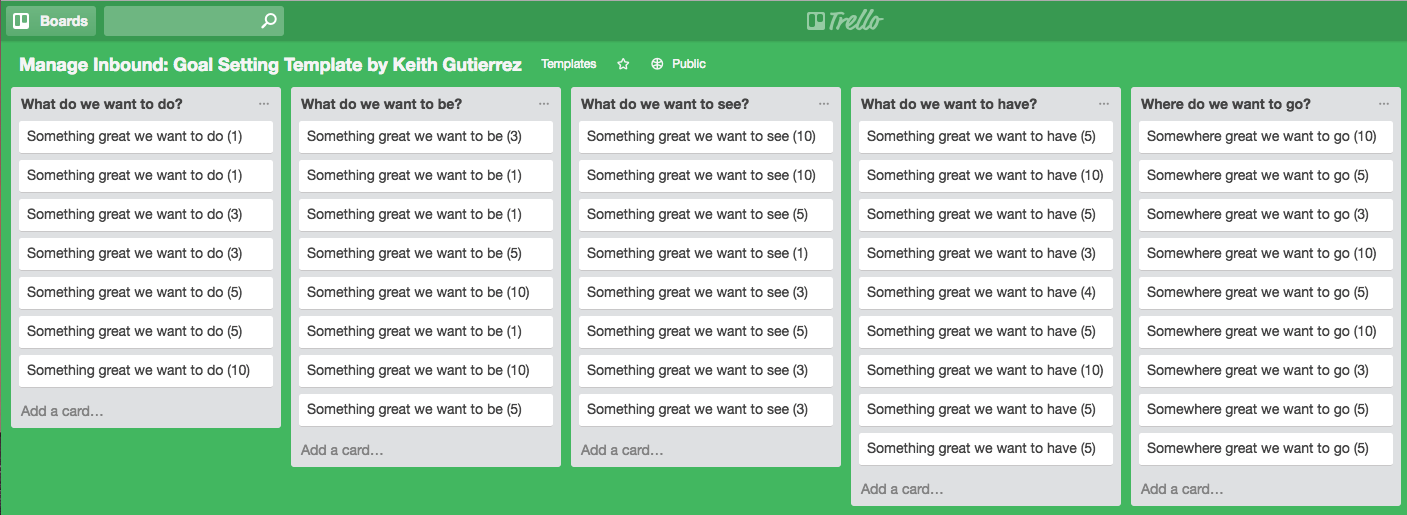
Put an (S) which stands for short-term goals next to any immediate business goals that your team may have — those that will take less than a year to achieve.
Then create another list called Short-Term Objectives and move any goals with an (S) by them to this list.
These are items that are within reach and can be accomplished in less than a year.

When you’re finished entering in all the time frames, move the goal cards into time frame groups and organize them by level of importance.
There should be a fairly balanced distribution of all the goals. Keep working with your team on the list until you’ve create a more-or-less even distribution.

Now comes the challenge...
Review with your team and ask what’s really important, compared to what might just be somewhat fun.
Step 4: Choose The Most Important Goals
Choose 4 goals from each of the 4 time frames (1yr. 3yr. 5yr. 10yr.) These will become your 16 main business goals.
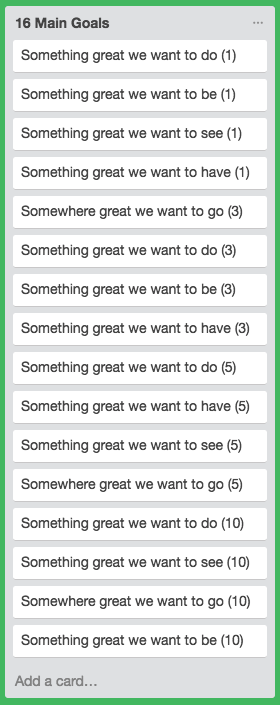
After your team has established their 16 main business goals, your team will want to go back through them and organize them in order of priority.
Write beside each of them either an A, B or C.
- A Goals – Something that is really exciting and of which the accomplishment might change your entire business. It’s something that your team would really like to achieve.
- B Goals – Something that your team would really want to achieve and that you would enjoy achieving and it’s important, but not quite as important as an “A Goal”.
- C Goals – Something that would be nice to do, nice to have or nice to achieve, but it’s not as important as an “A or B Goal.”
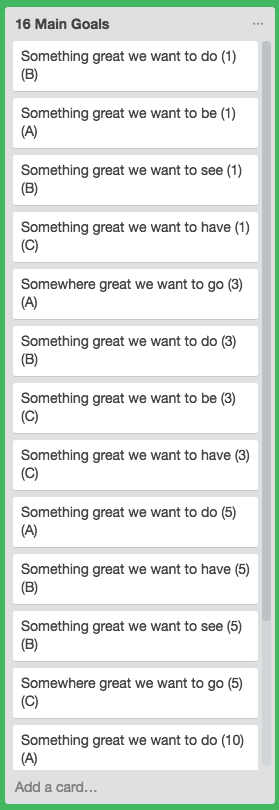
After you’ve identified your A, B and C goals, organize them by moving your most important goal to the top of the list, followed by the next most important “A Goal.”
Organize the remainder of your list in the same way.
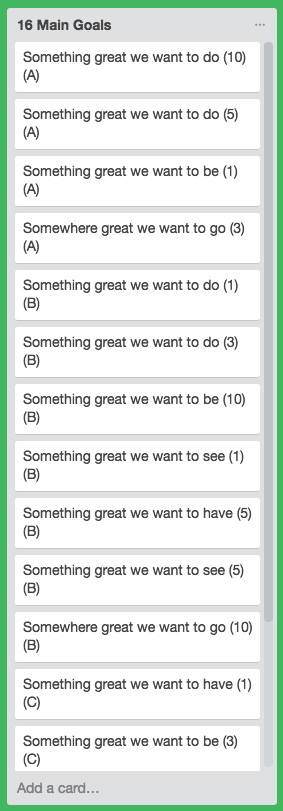
Once you’ve finished organizing your list in its order of priority, your top A goal should be your “Major Definite Purpose.”
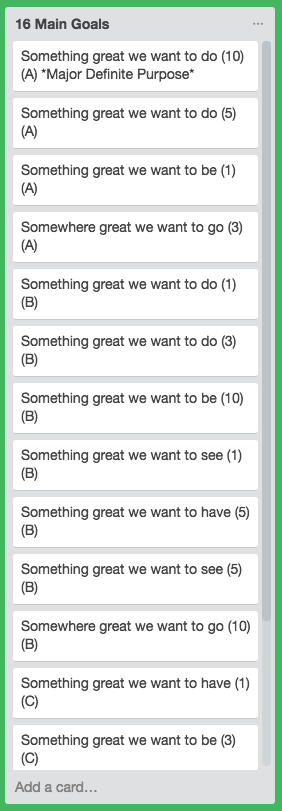
Step 5: Determine The Purpose
So far, you’ve only discovered your goals in short-hand fashion. But now you’re going to start seeing them very clearly in your mind’s eye.
A goal is a great motivator only if there is a powerful purpose behind it.
Your team should ask the following questions:
- What is our purpose for accomplishing this goal?
- Why do we want to achieve this goal? What are our reasons?
- Why is this not just a "should" but a "must" for us to accomplish this goal?
Encourage your team to let their emotions run free.
The emotional quality of purpose makes the sustainability of accomplishing these goals much more powerful.
A great way to do this is by using emotional triggers words that will really motivate your team to accomplish these goals.
Think about words that make your team crazy with excitement.
What words make you really want to do something?
Write down the answers to these questions inside the goal card for each of your main 16 business goals.
If you can’t find at least one clear and convincing reason for each of your main 16 goals, you'll want to do some serious re-evaluating.
You may have more whims or pipe dreams than real goals and now is the time to make that discovery.
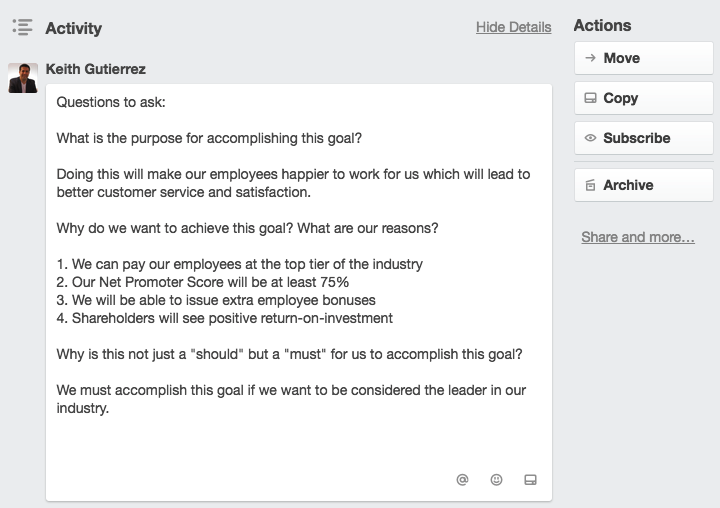
Step 6: Develop A MAP
![]()
Now that your team knows what the desired outcomes are and why they are important to your business, it's time to create a "Massive Action Plan" (MAP) to determine how you will accomplish these goals.
You'll want to start with your "Major Definite Purpose", then use the same process to create a "MAP" for your remaining goals.
To begin, let's assume we have a 10 year goal to generate $10 million in annual sales revenue.
Note: We are using a monetary example because it easy to follow. This does not mean that your MDP needs to be or should be monetary.
First sketch a timeline that includes specific milestones on how you plan to accomplish this goal over the given time frame.
- Year 1 - Generate $250,000 in annual revenue.
- Year 2 - Generate $350,000 in annual revenue = 40% growth
- Year 3 - Generate $500,000 in annual revenue = 42% growth
- Year 4 - Generate $750,000 in annual revenue = 50% growth
- Year 5 - Generate $1,150,000 in annual revenue = 53% growth
- Year 6 - Generate $1,750,000 in annual revenue = 52% growth
- Year 7 - Generate $2,700,000 in annual revenue = 54% growth
- Year 8 - Generate $4,200,000 in annual revenue = 55% growth
- Year 9 - Generate $6,500,000 in annual revenue = 54% growth
- Year 10 - Generate $10,000,000 in annual revenue = 53% growth
The reality is, things change and adjustments will need to be made along the way. Trying to make everything perfect in this step would most likely be a waste of time.
However, it is most important to make sure everyone on your team feels comfortable with the forecast and they feel the goal for year 1 is realistic and attainable.
Now you'll want to sketch a timeline for your remaining 3, 5, and 10 year goals. Just skip over the 1 year goals, we will address those in a moment.
Your time line sketches will provide you with a detailed overview of all the 1 year goals your team will need to consider.
Next you'll want to further outline your goals for year 1.
Using our example: Year 1 Goal - Generate $250,000 in annual revenue
- Mo. 1-3: $17,000 in monthly revenue
- Mo. 4-6: $19,000 in monthly revenue
- Mo. 7-9: $22,000 in monthly revenue
- Mo. 10-12: $25,334 in monthly revenue
Now let's suppose that we were selling a product that generated $2,000.00 in revenue with each sale.
- Mo. 1-3: $17,000 in monthly revenue = Average 8.5 sales each month
- Mo. 4-6: $19,000 in monthly revenue = Average 9.5 sales each month
- Mo. 7-9: $22,000 in monthly revenue = Average 11 sales each month
- Mo. 10-12: $24,680 in monthly revenue = Average 12.34 sales each month
Notice that the more near term, the more detailed your planning efforts will be.
That's because it's difficult to focus on goals that will take more than 90 days to accomplish.
Step 7: Setting 90 Day SMART Goals
![]()
When it comes to setting SMART goals, 90 days is the the perfect time frame. It's not too short to make progress and, it's not so far away that you end up losing focus or interest toward achieving the goal.
Now you may be wondering:
"What are SMART goals?"
SMART is a handy acronym for a goal setting framework that stands for:
- Specific - Your goal should be unambiguous and communicate what is expected, why it is important, who's involved, where it is going to take place, how is it going to happen and which constraints are in place
- Measurable - Your goal should have concrete criteria for measuring progress and reaching the goal
- Attainable - Your goal should be realistic and possible for your team to reach
- Relevant - Your goal should matter to your business and address a core initiative
- Timely - You should have an expected date that you will reach the goal
Source: Hubspot "How to set your SMART Goals in HubSpot"
SMART goals are great, but I don't recommend going through the trouble of making all your goals SMART. Instead, only use the framework on goals that can be accomplished in 90 days or less.
"Why?", you may ask.
Here are the two main reasons why:
1. The SMART goal setting framework can be limiting, especially with the concept of goals needing to be attainable. When you start goal setting you really should dream big, without limitations or constraints.
2. It can be a waste of time and resources to try to plan more than 90 days out. In most cases you'll end up needing to adjust or completely redefine the goals based on the data and results collected from your near-term efforts.
Now that we covered SMART Goals and when to use them, let's dive into how to create them.
Looking back at our example, our goal for months 1-3 is to generate $17,000 in monthly revenue = Averaging 8.5 sales each month
Let's suppose we are currently averaging 5 sales per month. To accomplish our goal we need to average 3.5 more sales over each of the next three months.
- Month 1 - Generate at least 3 additional product sales = 8 total sales
- Month 2 - Generate at least 4 additional product sales = 9 total sales
- Month 3 - Generate at least 4 additional product sales = 9 total sales
The list above provides us with insight into what we need to do, and the exact lag measures we will need to reach to accomplish them. What we haven't figured out is exactly how we plan to reach these goals.
To do that we need to adjust our mindset to focus on behaviors that will drive our desired results.
Setting the Lag Measures
Now let's take a closer look at our goal for Month 1: Generate at least 3 additional product sales, 8 total sales in the month.
The question we need to ask is: "How will we accomplish this goal?"
Let's suppose the answer is:
- Generate 1 new product sale through referrals
- Generate 1 new product sale through our traditional marketing efforts
- Generate 1 new product sale through our inbound marketing efforts
Inspired by the 4 Disciplines of Execution, the goals listed above are our Wildly Important Goals (W.I.G.s) for our sales and marketing teams this month.
If you're a small team that is responsible for running the everyday business operations, marketing, sales, etc., you should only focus on accomplishing up to 2 W.I.G.s at a time.
If your team has separate department heads, then each department can focus on accomplishing up to 2 W.I.G.s at a time. 2 for marketing, 2 for sales, etc.
The next question we need to ask is: "Who is responsible for accomplishing this goal?"
Let's zoom in on generating 1 new product sale through our inbound marketing efforts. To do that, let's say that we average a 25% close rate for SQL-to-Customer conversion.
With this data at hand our marketing team will be required to generate at least 4 new Sales Qualified Leads (SQLs) and the sales team will need to close at least 1 product sale from those 4 SQLs.
Now let's look specifically at how our marketing team will generate at least 4 new SQLs.
Let's say our inbound marketing efforts currently yield an average of 16% Marketing Qualified Leads (MQL)-to-SQL conversion rate. Based on this data, we will need to generate 25 new MQLs from our inbound marketing efforts.
Next let's drill down at how our marketing team will generate at least 25 new MQLs.
Suppose our inbound marketing efforts currently yield an average of 10% lead-to-MQL conversion rate. Based on this data, we will need to generate 250 new leads from our inbound marketing efforts.
Now let's look at how our marketing team will generate at least 250 new leads.
Let's presume our inbound marketing efforts currently yield an average of 5% visitor-to-lead conversion rate. Based on this data, we will need to generate at least 5,000 new website visitors.
Pause, take a deep breath..
I know, we've uncovered a lot of data.
With this data will come many more questions, such as:
- Is our SQL-to-Customer conversion rate too low? How can we do better?
- Is our MQL-to-SQL conversion rate too low? How can we do better?
- Is our Lead-to-MQL conversion rate too low? How can we do better?
- Is our Visitor-to-Lead conversion rate too low? How can we do better?
You get the picture...
Suppose that we would like to improve in all of these areas but our team has the most confidence in our conversion rate staying at 5%. This means that our main goal for our inbound marketing efforts is to generate a minimum of 5,000 visits over the next 3 months.
Setting the Lead Measures
Say we just checked our analytics dashboard and our site is currently generating 3,000 visits per month.
Then we analyzed our last 3 recently published blog posts and found each post we publish is averaging 1,500 new visits.
We also find each of these posts have generated at least 5 high quality inbound links, and over half of the page traffic is coming from these link referrals.
Did the light bulb turn on?
Now we know exactly what behaviors we must focus on to drive the desired results.
Doesn't it feel great?
Our inbound marketing team will need to do the following this month:
- Write and publish 2 new blog posts
- Build links through outreach to generate 5 inbound links for each post
The activities listed above are the Lead Measures that must be met to reach the desired Lag Measures.
The desired result of meeting our Lead Measures should be the accomplishment of our W.I.G.: 1 new product sale through our inbound marketing efforts, as long as our conversion rate stays the same or get better.
Document Your SMART Goals
Using our example listed above we will document our desired SMART goals for the inbound marketing team:
- Publish at least 2 blog posts that earn 5 inbound links to generate a minimum of 5,000 website visitors in the next 30 days
- Maintain a visitor-to-lead conversion rate of 5% over the next 30 days
- Maintain a lead-to-MQL conversion rate of 10% over the next 30 days
- Maintain a MQL-to-SQL conversion rate of 16% over the next 30 days
- Work with the sales team to maintain a SQL-to-Customer conversion rate of 25% over the next 30 days
Step 8: Keep a Compelling Scoreboard
![]()
Now you may be asking:
"All of this is great, but how do I keep my team motivated and engaged to accomplish these goals?"
And you'd be right to ask, because...
Even though you have clearly defined SMART goals and an effective plan, your team won't play at their best unless they are emotionally engaged. This only happens when they can tell if they are winning or losing.
The best way to do that is by keeping a compelling player scoreboard.
You'll want to get everyone on your team involved that is associated with the desired W.I.G.
Work with them to brainstorm ideas on how to best showcase the desired results vs. the current performance.
Decide where the scoreboard should be located. Make it easily visible to the entire team.
Finally, determine who responsible for keeping it up to date and, how often it will be updated.
Here's a great example of a scoreboard for lag measures that is built-in to HubSpot's Marketing Software.

The HubSpot Marketing Dashboard will also allow you to set specific goals for each month and then compare your results directly with your goals for visits, contacts, and customers.
We've created this handy scoreboard for tracking your W.I.G., Lag and Lead Goals. You can print one for each day, or each week depending on how frequently you want to analyze your progress.
Click on the image below to get instant access to the downloadable PDF version.
Remember, if you're not keeping score you're just practicing.
Step 9: Hold Your Team Accountable
Now that we've designed a game plan that's clear and effective, without consistent accountability your team most likely will not give their best effort to the game.
The best way to hold your team accountable is by conducting a weekly W.I.G. session, where your team can learn from their successes and failures.
Hold the W.I.G. session on the same day at the same time each day of the week. Meet standing up in a quiet communal space if possible. Keep the sessions brief 15-20 minutes in length.
If you're using the scoreboard template we've provided above, have the person responsible for updating the scoreboard bring it to the meeting to review the teams process each week.
You'll want each team leader to report on last week's commitment. Make sure they state the commitment and state the outcome.
Work with your team to find ways to remove any obstacles and propose any new commitments necessary to raise the lead measures to the desired levels.
Did I Miss Anything?
I hope you enjoyed this guide on how to set marketing and sales goals.
And now it's time to hear from you.
What do you think of the goal setting guide and the free templates?
Or maybe there was a bit of goal setting advice that I missed.
Either way, let me know by leaving a quick comment below.
Curious about inbound for your business? Check us out!
Share this
Sign up for blog updates!
Related Stories

Agentic AI Architecture: Building Scalable Autonomous Systems

What is Agentic AI and Why It Matters


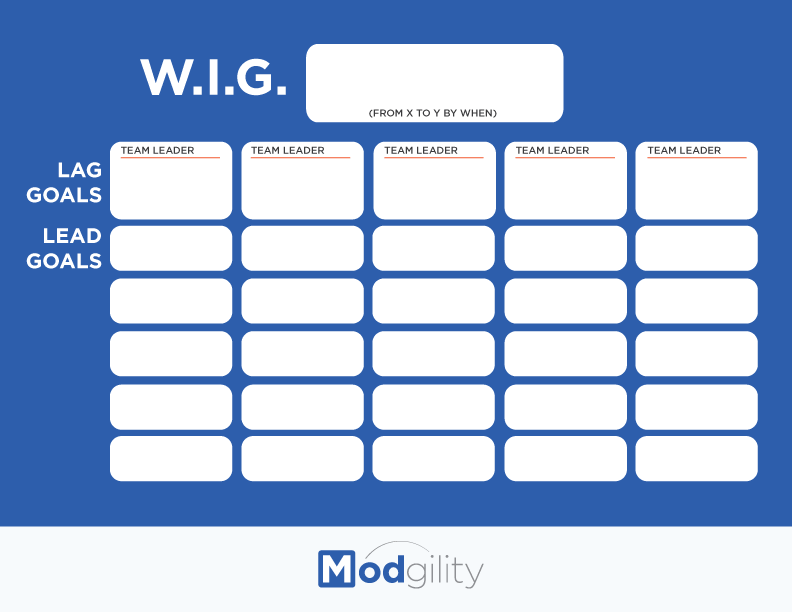
Leave a comment
Let us know what you think